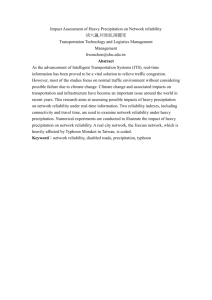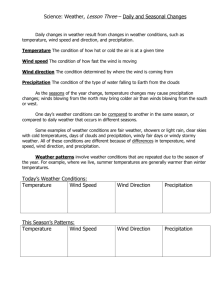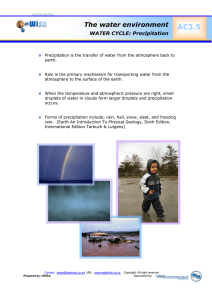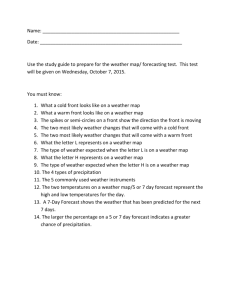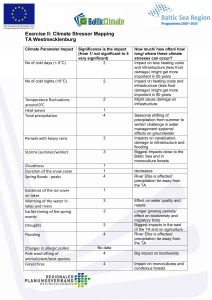Computer maps and weather (climate) data
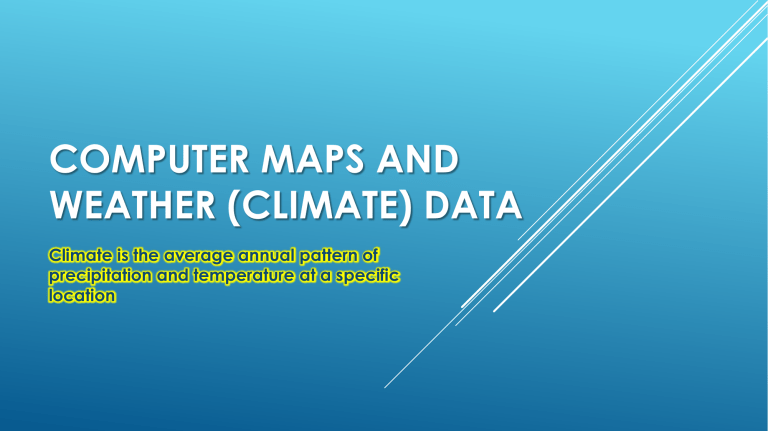
COMPUTER MAPS AND
WEATHER (CLIMATE) DATA
Climate is the average annual pattern of precipitation and temperature at a specific location
COMPUTER TEMPERATURE MAPS FOR
JANUARY 18, 2016
CURRENT TEMP
EXPECTED
HIGH TEMP
FOR THE DAY
THE FARTHER
ONE PREDICTS
FROM
TODAY’S
CONDITIONS,
THE LESS
ACCURATE
THE RESULTS
MAY BE.
GOOD TO
KNOW WHEN
YOU GO TO
BED SO YOU
WILL BE
PREPARED IN
THE
MORNING
ONE CAN GET MAPS
THAT PREDICT THE
TEMPERATURES FOR THE
NEXT 15 HOURS. ONE
CAN ALSO GET MAPS
OF CITY REGIONS.
ONE CAN GET MAPS
THAT PREDICT THE WIND
CHILL FOR THE NEXT 15
HOURS. ONE CAN ALSO
GET MAPS FOR CITY
REGIONS
THESE ALSO ARE
AVAILABLE FOR THE
NEXT 15 HOURS.
ALSO AVAILABLE FOR
CITY REGIONS FOR
THE NEXT 15 HOURS
SHOWS HOW
DIFFERENT TODAY
IS FROM THE
AVERAGE FOR
THE DAY
FARMERS
AND
GARDENERS
ARE MORE
INTERESTED IN
THIS IN THE
SPRING OF
THE YEAR
SHOWS WHEN
FARMERS AND
GARDENERS ARE
MOST NERVOUS
TRYING TO DECIDE
WHEN TO PLANT
WHICH SEEDS.
NATURE DOES NOT
ALWAYS PAY
ATTENTION TO THE
AVERAGES.
NOW LETS SEE WHAT WE CAN LEARN
ABOUT PRECIPITATION
ONE CAN GET MAPS
THAT PREDICT THE TYPE
OF PRECIPITATION
POSSIBLE FOR THE NEXT
15 HOURS. ONE CAN
ALSO GET MAPS OF CITY
REGIONS.
FOR JANUARY 18,
2016,
CONDITIONS ARE
RATHER UNIFORM
ALL AROUND ST.
LOUIS, MISSOURI
SHOWS THE
POSSIBLE
QUANTITY OF
PRECIPITATION IN
LIQUID MEASURE
FOR THE NEXT 15
HOURS
SHOWS THE
PROBABILITY OF
PRECIPITATION
FOR THE NEXT 3
DAYS. CITY
REGIONS CAN
ALSO BE
SELECTED
OTHER DATA AVAILABLE THAT IMPACT
WEATHER, AND THEREBY CLIMATE
JET STREAMS
AFFECT THE
MOVEMENT OF
THE AIR MASSES AT
LOWER ALTITUDES
– JET STREAMS DO
NOT STAY IN ONE
PATTERN, THEY
MOVE ABOUT.
IF AN AREA REMAINS
RED LONG ENOUGH,
THEN IT IS HAVING A
DROUGHT. IF IT
STAYS GREEN TOO
LONG, THERE MAY
BE AGRICULTURAL
PROBLEMS OF
ANOTHER SORT AND
POSSIBLY FLOODING
WHEN THE
WATER VAPOR
IS ABUNDANT
(HIGH
HUMIDITY), THE
CHANCE OF
PRECIPITATION
INCREASES
the state of the atmosphere at a place and time as regards heat, dryness, sunshine, wind, rain, etc. Put very simply, weather is what hits you in the face when you walk out the door.
WEATHER
A FEW BASICS TO REMEMBER THAT AFFECT WEATHER
Land heats up faster and to a greater extent than water bodies (they have to heat the volume, whereas with land, only the surface heats and cools.
Land cools off faster and to a greater extent than water bodies (they have to cool the volume, whereas with land, only the surface heats and cools.
Generally speaking, as one ascends 1000 feet in altitude, the temperature drops, on the average, 2.6 degrees Fahrenheit.
Generally speaking, as one descends 1000 feet in altitude, the temperature rises, on the average, 2.6 degrees Fahrenheit.
Areas where warming air is ascending are called low pressure areas.
Areas where cooling air is descending are called high pressure areas.
Wind is a horizontal movement of air from a high pressure area to a low pressure area.
the average course or condition of the weather at a place usually over a period of years as exhibited by temperature, wind velocity, and precipitation. Usually the average ANNUAL PATTERN of temperature and precipitation arrived at over a long period of time – the longer the time period, the more reliable are the results.
Since climates are described using averages, they don’t express the extremes. How cold have the coldest nights been in the cool part of the year, and how hot did the hottest days in the warm part the year get? How much precipitation was received in the wettest year and in the driest year? Knowing the average patterns is helpful, but also knowing the extremes can be very important information if one is moving to a new area with a climate that is different from what one has become accustomed to experiencing.
C L I M A T E
Climate change is a condition that is always going on as factors beyond the earth (sun actions) and within and on the earth change. The proof is that we can accurately establish that there have been 4 ice ages on earth with long warm periods between them. Currently the earth is warming more rapidly than nature would have it warm because humans have filled the atmosphere with gasses (CO 2 being the major one) that hold heat. This will change conditions for many habitats, affecting the plants and animals that have been living there, but are now experiencing conditions that are less than ideal for them. If they can, they will migrate to areas where the habitat is more suitable for them.
Some countries are being threatened with shrinking or going out of existence as sea level rising (it is rising) puts most or all of them under water: Marshall
Islands, Maldives Islands, the cayes off the coast of Belize, just to mention an few of those threatened. Most seacoast cities around the world are going to have serious problems.
Problem: If a farmer can no longer successfully grow the crop he/she is used to growing, can he/she find an alternate crop that is equalably marketable, or is he/she economically wiped out?
CLIMATE CHANGE
For many, or even most people on the Earth it influences:
What kind of cloths are appropriate throughout the year
What foods are locally available
How varied one’s wardrobe (clothes) needs to be
What the features are of the home they need to protect them from whatever extremes nature presents where they are located
What kind of agriculture can be practiced in the area
What diseases they may be exposed to
What kind of recreation is available
Machinery maintenance
The potential for much of a tourist industry
Etc.
WHY DO YOU THINK CLIMATE STUDY IS IMPORTANT?
Meteorologists and climatologists started predicting that a warming of the average temperatures would result in more extreme weather condition and less predictability: stronger hurricanes with bigger storm surges on coasts (hurricane Sandy), melting glaciers and rising sea levels (already happening on Pacific coral islands), disease vectors’ territories would expand (Tsetse flies exist at higher altitudes in East Africa), rising ocean temperatures would change ecosystems (much of the coral on Pacific reefs has died due to the small rise in temperatures)
EXAMPLE OF CONNECTIONS: coral reefs are dying. Side effects: the living coral reefs were the breeding and feeding grounds for many ocean creatures and provided hiding places and camouflage for small fish trying to avoid big predators. This would mean a serious decrease in many species of ocean life.
A decrease in many fish species could put many small fishermen around the world out of business and reduce the food supply for countries (like Japan) that depend a lot on fish to feed their populations
WHAT’S THE BIG DEAL ABOUT CLIMATE CHANGE?
The Four Laws of Ecology
Everything is connected.
Everything goes somewhere
Nature knows best
There is no such thing as a free lunch.
REMEMBER THE FOUR BASIC LAWS OF
ECOLOGY? CAN YOU SEE HOW THEY
APPLY TO THE SITUATION DESCRIBED IN THE
PREVIOUS SLIDE?
